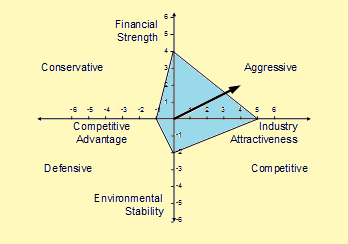Strategic Position and Action Evaluation Matrix (SPACE) is “an approach to hammer out an appropriate strategic posture for a firm and its individual business.” SPACE is an analysis of the following four dimensions in as in a two-dimensional portfolio analysis and involves a consideration of:
- Company’s competitive advantage
- Company’s financial strength
- Industry strength
- Environmental stability
Various factors are evaluated for determining each of the dimensions and they are summarized below:
| Dimensions | Factors Evaluated |
| Company’s competitive advantage |
|
| Company’s Financial Strength |
|
| Industry Strength |
|
| Environmental Stability |
|
Steps essential to construct a Strategic Position and Action Evaluation Matrix are described below:
- Choose a combination of factors that best characterize Competitive Advantage (CA), Environmental Stability (ES), Financial Strength (FS) and Industry Strength (IS).
- To the CA and ES dimensions allot a numerical value ranging from -6 (worst) to -1 (best) to each of the factors. Allot value ranging from +6 (best) to +1 (worst) to all of the factors that constitute the IS and FS dimensions.
- Calculate an average score for IS, ES, CA and FS by summing the numbers allotted to the factors of the entire dimension separately and dividing by the set of factors included in the particular dimension.
- Plot the average scores for each dimensions such as ES, CA, IS and FS on the proper axis in the matrix.
- Add or combine the scores of two dimensions that lay in the x-axis and design the resultant point on X, in the same way add scores of dimensions that lay in the y-axis and plot the consequential point on Y. Then, plot the intersection of the both new XY points.
- Sketch a directional vector from the basis of the Strategic Position and Action Evaluation (SPACE) matrix throughout the new intersection points. This vector discloses the kind of strategies suggested for the firm such as aggressive, defensive, conservative or competitive.
Using the Strategic Position and Action Evaluation Matrix method we find the strategic position/posture of an organisation. We have analyzed four dimensions in this method; two contribute to the internal dimensions and the other two to external dimensions. The internal dimension includes competitive advantage and the financial strength which are the major factors to determine the strategic position of any organization. The external dimension includes the industry strength and the environmental stability which is used to identify the strategic position in the industry. By evaluating these four dimensions, we result in four different strategic postures namely;
- Aggressive Posture indicating that the company can fully exploit available opportunities and enhance its market share. As the company has high financial strength, high industry strength, enjoys competitive advantage and belongs to an attractive industry and operates in a relatively stable environmental conditions. This posture is a kin to Michael Porter’s generic strategy of overall cost leadership.
- Competitive Posture indicating limited financial strength, medium competitive advantage in an attractive industry and operating in a relatively volatile or unstable environment, necessitating the company to maintain and enhance competitive advantage by improving/differentiating product; widening the product line, improving marketing effectiveness and mobilizing, augmenting financial resources. This posture is considered to be quite similar to Michael Porter’s generic strategy of product differentiation.
- Conservative Posture indicating a company having limited competitive advantage, in a not so attractive industry but enjoying financial strength and operating in a relatively stable environment. Such a company should endeavor to cut down non-performing product, control costs, improve productivity, introduce new products and enhance sales by profitable market expansion. This posture can be compared with Michael Porter’s generic strategy of focus.
- Defensive Posture indicates a company that lacks both competitive advantage and financial strength and belongs to a not-so-attractive industry and operates in an unstable environment. All the four dimensions are weak and works against the company. It is advisable for a such a company to initiate measures like discontinue nonviable products, tightly control costs and monitor cash flows strictly, cutting down/reducing capacity and postponing or limiting investments.
The basic strategic posture, determines the appropriate financial as regards the project related investment. After identifying the appropriate posture of an organisation, which in turn helps to identify the organisation generic competitive strategies. This leads to define the strategic thrust for the business. Afterwards the mangers or the top level management of the organisation can choose the appropriate strategy in which their organisation needs to focus to achieve the strategic objective and goal.
Thus we can say the Strategic Position and Action Evaluation Matrix will help the organisation to formulate its strategic goal and help to identify its competitive position in the market space. If we need to make decision based on two or more strategic factors, then we need to go for the other tool called Quantitative Strategic Planning Matrix (QSPM).
